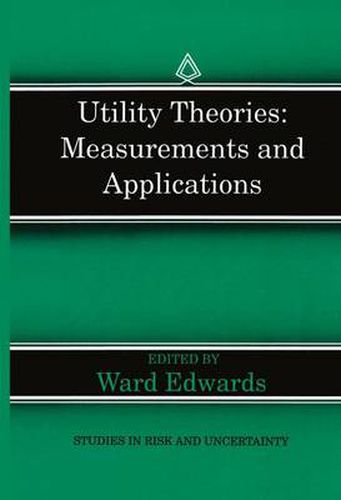Readings Newsletter
Become a Readings Member to make your shopping experience even easier.
Sign in or sign up for free!
You’re not far away from qualifying for FREE standard shipping within Australia
You’ve qualified for FREE standard shipping within Australia
The cart is loading…






This title is printed to order. This book may have been self-published. If so, we cannot guarantee the quality of the content. In the main most books will have gone through the editing process however some may not. We therefore suggest that you be aware of this before ordering this book. If in doubt check either the author or publisher’s details as we are unable to accept any returns unless they are faulty. Please contact us if you have any questions.
The Conference on Utility: Theories, Measurements, and Applications met at the Inn at Pasatiempo in Santa Cruz, California, from June II to 15, 1989. The all-star cast of attendees are listed as authors in the Table of Contents of this book (see p. V), except for Soo Hong Chew and Amos Tversky. The purpose of the conference, and of National Science Foundation Grant No. SES-8823012 that supported it, was to confront proponents of new generalized theories of utility with leading decision analysts com mitted to the implementation, in practice, of the more traditional theory that these new theories reject. That traditional model is variously iden tified in this book as expected utility or subjectively expected utility maximization (EU or SEU for short) and variously attributed to von Neumann and Morgenstern or Savage. I had feared that the conference might consist of an acrimonious debate between Olympian normative theorists uninterested in what people actually do and behavioral modelers obsessed with the cognitive illusions and uninterested in helping people to make wise decisions. I was entirely wrong. The conferees, in two dramatic straw votes at the open ing session, unanimously endorsed traditional SEU as the appropriate normative model and unanimously agreed that people don’t act as that model requires. (These votes had a profound impact on my thinking; detail about them and about that impact is located in Chapter 10.
$9.00 standard shipping within Australia
FREE standard shipping within Australia for orders over $100.00
Express & International shipping calculated at checkout
This title is printed to order. This book may have been self-published. If so, we cannot guarantee the quality of the content. In the main most books will have gone through the editing process however some may not. We therefore suggest that you be aware of this before ordering this book. If in doubt check either the author or publisher’s details as we are unable to accept any returns unless they are faulty. Please contact us if you have any questions.
The Conference on Utility: Theories, Measurements, and Applications met at the Inn at Pasatiempo in Santa Cruz, California, from June II to 15, 1989. The all-star cast of attendees are listed as authors in the Table of Contents of this book (see p. V), except for Soo Hong Chew and Amos Tversky. The purpose of the conference, and of National Science Foundation Grant No. SES-8823012 that supported it, was to confront proponents of new generalized theories of utility with leading decision analysts com mitted to the implementation, in practice, of the more traditional theory that these new theories reject. That traditional model is variously iden tified in this book as expected utility or subjectively expected utility maximization (EU or SEU for short) and variously attributed to von Neumann and Morgenstern or Savage. I had feared that the conference might consist of an acrimonious debate between Olympian normative theorists uninterested in what people actually do and behavioral modelers obsessed with the cognitive illusions and uninterested in helping people to make wise decisions. I was entirely wrong. The conferees, in two dramatic straw votes at the open ing session, unanimously endorsed traditional SEU as the appropriate normative model and unanimously agreed that people don’t act as that model requires. (These votes had a profound impact on my thinking; detail about them and about that impact is located in Chapter 10.